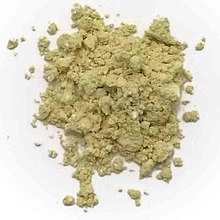 NaBiO3 powder.
| |
| Names | |
|---|---|
| Other names
Sodium bismuth oxide
| |
| Identifiers | |
3D model (JSmol)
|
|
| ChemSpider | |
| ECHA InfoCard | 100.032.220 |
| EC Number |
|
PubChem CID
|
|
| UNII | |
CompTox Dashboard (EPA)
|
|
| |
| |
| Properties | |
| NaBiO3 | |
| Molar mass | 279.968 g/mol |
| Appearance | Yellow to yellowish-brown odorless powder[1] |
| Density | 6.50 g/cm3 |
| Insoluble in cold, decomposes in hot water[2] | |
| Hazards | |
| GHS labelling: | |

| |
| Warning | |
| H302, H315, H319, H335 | |
| P261, P264, P270, P271, P280, P301+P312, P302+P352, P304+P340, P305+P351+P338, P312, P321, P330, P332+P313, P337+P313, P362, P403+P233, P405, P501 | |
| Lethal dose or concentration (LD, LC): | |
LD50 (median dose)
|
420 mg/kg (rat, oral)[1] |
| Related compounds | |
Other anions
|
Sodium antimonate |
Other cations
|
Potassium bismuthate |
Related compounds
|
Sodium hexafluorobismuthate(V) |
Except where otherwise noted, data are given for materials in their standard state (at 25 °C [77 °F], 100 kPa).
| |
Sodium bismuthate is an inorganic compound, and a strong oxidiser with chemical formula NaBiO3.[3] It is somewhat hygroscopic,[2] but not soluble in cold water, which can be convenient since the reagent can be easily removed after the reaction. It is one of the few water insoluble sodium salts. Commercial samples may be a mixture of bismuth(V) oxide, sodium carbonate and sodium peroxide.[4]
A related compound with the approximate formula Na3BiO4 also exists.[5]
- ^ a b "Sodium bismuthate". Mallinckrodt Baker. 2007-06-19.
- ^ a b The Merck index (12th ed.). Chapman & Hall Electronic Pub. Division. 2000. p. 1357. ISBN 9781584881292.
- ^ Greenwood NN, Earnshaw A (1997). Chemistry of the Elements (2nd ed.). Butterworth-Heinemann. ISBN 978-0-08-037941-8.
- ^ Suzuki & Matano 2001, pp. 1–20.
- ^ Sascha V (2004). Konformationsaufklärung anorganischer Oxoanionen des Kohlenstoffs und Festkörpersynthesen durch Elektrokristallisation von Ag3O4 und Na3BiO4 (PDF) (Ph.D.) (in German). Max-Planck-Institut für Festkörperforschung, Stuttgart. doi:10.18419/opus-6540.